
Agnostida are an order of extinct arthropods which have classically been seen as a group of highly modified trilobites, though some recent research has doubted this placement. Regardless, they appear to be close relatives as part of the Artiopoda. They are present in the Lower Cambrian fossil record along with trilobites from the Redlichiida, Corynexochida, and Ptychopariida orders, and were highly diverse throughout the Cambrian. Agnostidan diversity severely declined during the Cambrian-Ordovician transition, and the last agnostidans went extinct in the Late Ordovician.

Trilobites are extinct marine arthropods that form the class Trilobita. Trilobites form one of the earliest known groups of arthropods. The first appearance of trilobites in the fossil record defines the base of the Atdabanian stage of the Early Cambrian period and they flourished throughout the lower Paleozoic before slipping into a long decline, when, during the Devonian, all trilobite orders except the Proetida died out. The last extant trilobites finally disappeared in the mass extinction at the end of the Permian about 251.9 million years ago. Trilobites were among the most successful of all early animals, existing in oceans for almost 270 million years, with over 22,000 species having been described.

Redlichiida is an order of trilobites, a group of extinct marine arthropods. Species assigned to the order Redlichiida are among the first trilobites to appear in the fossil record, about halfway during the Lower Cambrian. Due to the difficulty to relate sediments in different areas, there remains some discussion, but among the earliest are Fallotaspis, and Lemdadella, both belonging to this order. The first representatives of the orders Corynexochida and Ptychopariida also appear very early on and may prove to be even earlier than any redlichiid species. In terms of anatomical comparison, the earliest redlichiid species are probably ancestral to all other trilobite orders and share many primitive characters. The last redlichiid trilobites died out before the end of the Middle Cambrian.

Harpetida is one of the eleven orders of the extinct arthropod class Trilobita. The first harpetid trilobites appear in the Upper Cambrian, and the last species die out at the end of the Devonian period.

Asaphida is a large, morphologically diverse order of trilobites found in marine strata dated from the Middle Cambrian until their extinction during the Silurian. Asaphida contains six superfamilies, but no suborders. Asaphids comprise some 20% of described fossil trilobites.

Phacopida ("lens-face") is an order of trilobites that lived from the Late Cambrian to the Late Devonian. It is made up of a morphologically diverse assemblage of taxa in three related suborders.

Ptychopariida is a large, heterogeneous order of trilobite containing some of the most primitive species known. The earliest species occurred in the second half of the Lower Cambrian, and the last species did not survive the Ordovician–Silurian extinction event.

Proetida is an order of trilobite that lived from the Ordovician to the Permian. It was the last order of trilobite to go extinct, finally dying out in the Permian-Triassic extinction event.

The Phacopina comprise a suborder of the trilobite order Phacopida. Species belonging to the Phacopina lived from the Lower Ordovician (Tremadocian) through the end of the Upper Devonian (Famennian). The one unique feature that distinguishes Phacopina from all other trilobites are the very large, separately set lenses without a common cornea of the compound eye.
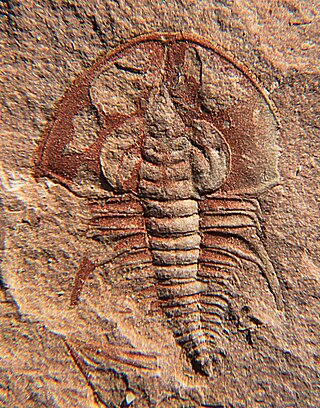
Olenellina is a suborder of the order Redlichiida of trilobites that occurs about halfway during the Lower Cambrian, at the start of the stage called the Atdabanian. The earliest trilobites in the fossil record are arguably Olenellina, although the earliest Redlichiina,Ptychopariida, and Eodiscina follow quickly. The suborder died out when the Lower Cambrian passed into the Middle Cambrian, at the end of the stage called Toyonian. A feature uniting the Olenellina is the lack of rupture lines in the headshield, which in other trilobites assist the periodic moulting, associated with arthropod growth. Some derived trilobites have lost facial sutures again, but all of these are blind, while all Olenellina have eyes.
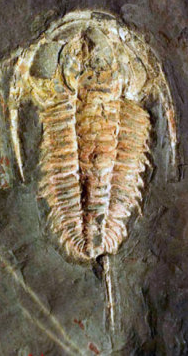
Redlichiina is a suborder of the order Redlichiida of Trilobites. The suborder contains three superfamilies: Emuelloidea, Redlichioidea and Paradoxidoidea. These trilobites are some of the oldest trilobites known. They originated at the beginning of the Cambrian Period and disappeared at the end of the middle Cambrian.

Acastoidea is a superfamily of trilobites from the order Phacopida, suborder Phacopina. This superfamily is divided into two families, Acastidae and Calmoniidae. This superfamily is distinguishable from the Phacopidae in that eyes are closer to the glabella and that the glabella has lobes, unlike the genera in Phacopidae. Acastoidea was first proposed by T.J.A. Reijers in 1972.

Acastidae is a family of trilobites in the order Phacopida, suborder Phacopina, superfamily Acastoidea, containing the following genera:
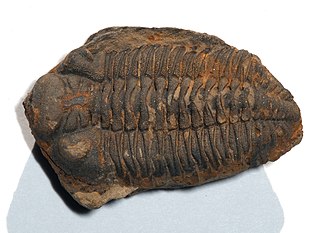
Calmoniidae is a family of trilobites from the order Phacopida, suborder Phacopina, superfamily Acastoidea.

The ”Fallotaspidoidea” are a superfamily of trilobites, a group of extinct marine arthropods. It lived during the Lower Cambrian (Atdabanian) and species occurred on all paleocontinents except for the Gondwana heartland. A member of this group, Profallotaspis jakutensis, has long been the earliest known trilobite, but recently the redlichiid Lemdadella has been claimed as occurring even earlier.
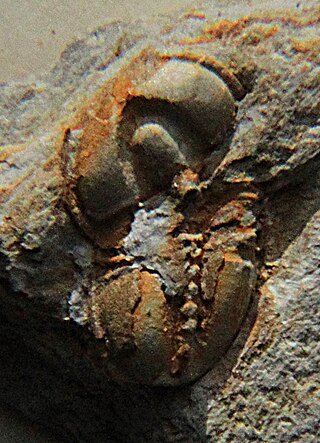
Eodiscina is trilobite suborder. The Eodiscina first developed near the end of the Lower Cambrian period and became extinct at the end of the Middle Cambrian. Species are tiny to small, and have a thorax of two or three segments. Eodiscina includes six families classified under one superfamily, Eodiscoidea.
The Burlingiidae constitute a family of trilobites of uncertain affinity, that lived during the Middle to lowest Upper Cambrian. Burlingiids have a cosmopolitan distribution, can be found in deposits that originate from outside the continental shelves, and may have been planktonic. They are characterized by their oval shape, small size, proparian sutures, and non-functional articulations of the thorax. Uniquely the anterior borders of the pleura are raised, and there are between 8 and 15 thorax segments. Burlingiid trilobites have been found in Norway, Sweden, Northern Siberia, Eastern and South-eastern China, Australia (Tasmania), India (Himalayas) and the United Kingdom.

Ptychoparioidea is a superfamily of the Ptychopariida order of trilobites.
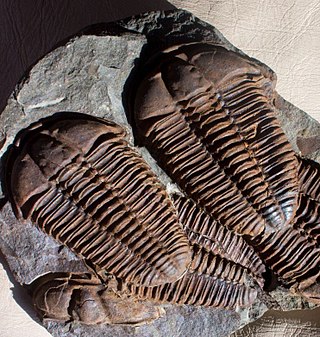
Ptychopariina is an extinct suborder of trilobites of the order Ptychopariida. Also known as the primitive Ptychopariida, they are a notably wide and varied taxon. Some of the representative genera include Elrathia, Densonella, Norwoodia, Tricrepicephalus, Conocoryphe, and Modocia.
Ellipsocephaloidea is a superfamily of trilobites that lived during the Cambrian period. It was first described by Lin in 1990.


















